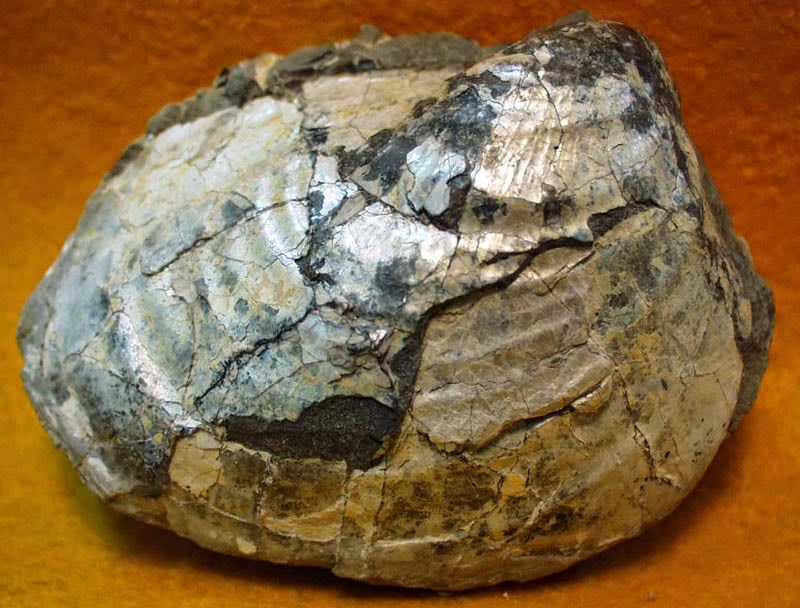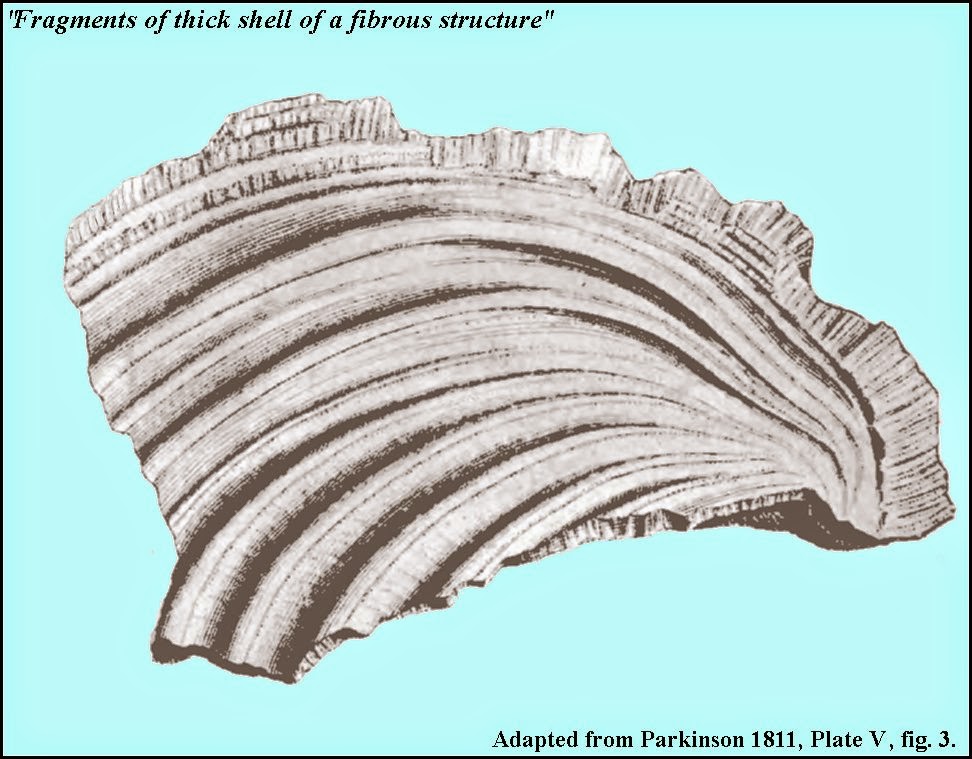
Inoceramus, genus of extinct pelecypods (clams) found as fossils in Jurassic to Cretaceous rocks (laid down between 199.6 million and 65.5 million years ago). Especially important and widespread in Cretaceous rocks, Inoceramus had a distinctive shell; it is large, thick, and wrinkled in a concentric fashion, making identification relatively simple. The many pits at the dorsal region were the anchoring points for the ligaments that closed the shell.
Inoceramids: Some species of clams (bivalves) grew to giant size in the late Cretaceous, attaining diameters of four feet or more. In cross section, these shells are composed of prismatic (calcitic) crystals. The inner, nacreous (Mother of Pearl) layer of the shell (composed of aragonite) was usually dissolved during fossilization and the outer portion is usually covered with colonies of oysters and other invertebrates. Pearls are occasionally found pressed into the Inoceramid shell. According to Sowerby 1823, Inoceramus means “fibrous shell,” describing the prisms that are visible on the edge of shell fragments.
Inoceramus cuvieri was the first species of Inoceramus that was formally described by Sowerby (1814). Several species are found in the Late Cretaceous rocks of Kansas. At times in the Western Interior Sea, they provided shelter for various small fishes and at least one species of eel. They also produced pearls.
Inoceramid shells were discovered in Great Britain and France in the late 1700s and early 1800s, but they were seldom found complete. Europe in the James Parkinson (1811b) wrote one of the first descriptions of inoceramid shell fragments, in this case Inoceramus cuvieri from the English chalk:
 “Fragments of thick shell of a fibrous structure: The doubts expressed respecting the nature of this shell, and the observations made with regard to it, offer another strong point of agreement between the shells of the two strata. The shell here alluded to is most probably that represented Org. Rem. vol. III. pl. V.-fig. 3; the structure of which agrees exactly with that mentioned as found in the French stratum of- chalk. That shell is however described as being of a tubular form; it is therefore right to observe, that fossil that represented Org. Rem. vol. III. pl. V.-fig. 3; the structure of which agrees exactly with that mentioned as found in the French stratum of- chalk. That shell is however described as being of a tubular form; it is therefore right to observe, that fossil pinnae do sometimes possess this peculiar structure.”
“Fragments of thick shell of a fibrous structure: The doubts expressed respecting the nature of this shell, and the observations made with regard to it, offer another strong point of agreement between the shells of the two strata. The shell here alluded to is most probably that represented Org. Rem. vol. III. pl. V.-fig. 3; the structure of which agrees exactly with that mentioned as found in the French stratum of- chalk. That shell is however described as being of a tubular form; it is therefore right to observe, that fossil that represented Org. Rem. vol. III. pl. V.-fig. 3; the structure of which agrees exactly with that mentioned as found in the French stratum of- chalk. That shell is however described as being of a tubular form; it is therefore right to observe, that fossil pinnae do sometimes possess this peculiar structure.”
Scientific classification
Domain: Eukaryota Whittaker & Margulis,1978 – eukaryotes
Kingdom: Animalia Linnaeus, 1758 – animals
Subkingdom: Bilateria (Hatschek, 1888) Cavalier-Smith, 1983 – bilaterians
Branch: Protostomia Grobben, 1908 – protostomes
Superphylum: Eutrochozoa
Phylum: Mollusca (Linnaeus, 1758) Cuvier, 1795 – Molluscs
Class: Bivalvia – Bivalves
Order: Pterioida
Family: Inoceramidae
Genus: Inoceramus
Description
The clam had a thick shell paved with “prisms” of calcite deposited perpendicular to the surface, which gave it a pearly luster in life. Most species have prominent growth lines which appear as raised semicircles concentric to the growing edge of the shell. Paleontologists suggest that the giant size of some species was an adaptation for life in the murky bottom waters, with a correspondingly large gill area that would have allowed the animal to survive in oxygen-deficient waters.
Distribution
Species of Inoceramus had a worldwide distribution during the Cretaceous period. Many examples are found in the Pierre Shale of the Western Interior Seaway in North America. Inoceramus can also be found abundantly in the Cretaceous Gault Clay that underlies London. Other locations for this fossil include Vancouver Island, British Columbia, Canada; Texas, Tennessee, Kansas, California and Alaska, USA; Spain, France, and Germany.
Reference:
Inoceramids , Giant clams of the Cretaceous : OCEANS OF KANSAS PALEONTOLOGY
Inoceramus : Wikipedia
USGS : Upper Cretaceous Pelecypods of the Genus Inoceramus from Northern Alaska
Inoceramus Taxonomy : zipcode zoo










